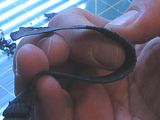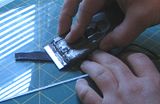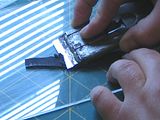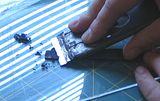
Hold your piece of leather down on the plexi with one hand and hold the scraper int eh other. Hold the scraper at about a 45 degree angle.


Now push gently on the scraper, while holding down on the leather.

If you’ve gothe right angle and pressure you’ll feel the blade catch and it will start to scrape up bits of leather. Depending on the leather you’ll get different results. I’m using a soft but fairly stiff cowhide here.



I found that short shallow strokes followed by longer gentle strokes got the best production for me and made the process faster.
You see the pile of shavings? Keep that out of the way. If those parings get under your work you’ll end up with a hole in the leather and it won’t be pretty.



Work slow and patiently other wise you’ll misjudge how much thickness you have left and cut right through the leather.
Here’s what I ended up with:

I’m able to use this method successfully on thin leather pieces and leather pieces less wide than my blade. I also found that I was able to use it on corners to successfully thin those down for a turn in. Some leathers worked better than other- thick stiff leathers withstood the razor better than soft leathers. All my cowhides worked especially well and I was able to shave them down to the mere-est surface of the skin. They also showed the least amount of stretching. Heavy weight deer hide worked pretty well too. Soft and smooth sheep hide faired the least well of all the hides tried. THOUGH the thin straps I use for bookmarks did well. Anything with texture lost that in the process.

No comments:
Post a Comment